On January 24, 2015, Viktor Pešta won a unanimous decision over Konstantin Erokhin. Below are the secrets to his strength training.
Viktor’s MMA coach, Dan Barták, and his gym, Penta Gym Prague, were voted as best MMA gym and best MMA coach of 2014. Moreover, Viktor left for Sweden to Allstars Training Center and later to Alliance MMA in the U.S. to train with elite MMA coaches and athletes like Alexander Gustafsson and Phil Davis. As far as MMA preparation was concerned, he had great coaching. Strength and conditioning, on the other hand, was a different story. Viktor says:
“As for strength and conditioning prep, I didn’t have any systematic approach before. Sometimes I did a CrossFit WOD or some circuit training, or visited a regular gym.“
It was time to change that. Our KB5 Gym Prague took over his movement, strength and conditioning prep.
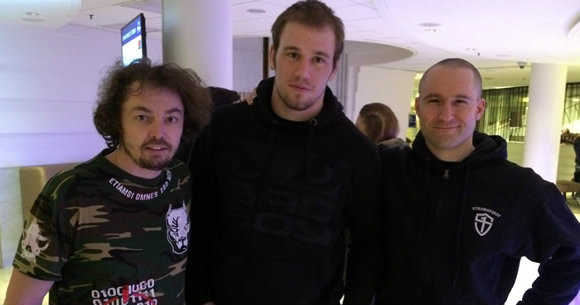
Below is a short summary of our basic MMA prep for Viktor and his brothers-in-arms. As you read through, take careful note that everything we did was made to enhance his skill in his sport; anything that could have gotten in the way was mercilessly avoided or removed. A solid lesson in training any of your clients – be they athletes or average Joes and Janes.
Begin by Assessing Movement Quality
First and foremost, we ran Viktor (as well as other fighters) through the FMS screen and assigned him a few corrective exercises to take the brakes off of his body and unlock his power (hamstring stretch, hip flexor stretch, and T-spine mobility drill).
We also taught Viktor a short Original Strength resets sequence, as well as Simple & Sinister (S&S) kettlebell warmup. Ten minutes each training session and he was done, ready to move on to the meat of the program.
S&C Training for MMA Means GPP
Our StrongFirst-based strength and conditioning program included kettlebell, bodyweight, and barbell work. As the entry tool, I chose the kettlebell and put Viktor on an S&S program (i.e., kettlebell swings and get-ups). S&S in the mornings, MMA training later in the day, and both almost daily. Viktor commented:
“When I started to train according the StrongFirst methodology in the KB5 Gym, I didn’t like it in the beginning that much because Pavel was very strict about working on proper technique first. But when we started to lift heavier weights, everything changed and I started to enjoy the practice a lot.”
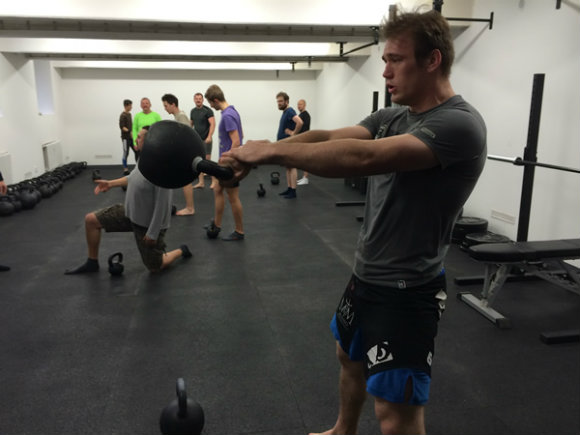
Once Viktor got to heavier get-ups (36 kg+), we started to alternate get-ups with push presses (Pavel Tsatsouline’s recommendation). One day we did swings and get-ups, the other day swings and push presses. Push presses were also done in an S&S way – 10×10 with a focus on maximum power output, with Fast & Loose shadow boxing between the rounds.
I was very careful about the maximum explosiveness in Viktor’s swings and push presses, and the breathing and recovery between the rounds, as well as control and proper movement in his get-ups.
Viktor quickly got to 40-44kg kettlebells in his swings and get-ups, and a 28kg kettlebell in push presses. On couple of occasions, I had him deload the weight to make sure every single rep stayed crisp and strict. We didn’t worry about breaking lifting records or learning more complex exercises – he is an MMA fighter, not powerlifter or girevik.
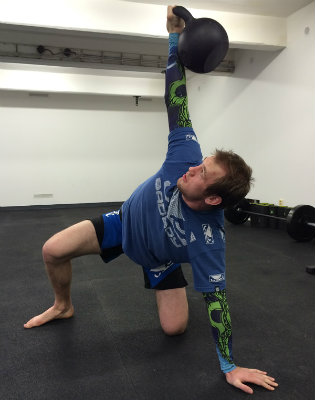
Tempting as it may be to allow your ego to get the better of you, whenever you are training a professional athlete anything that does not directly improve the qualities required by their sport must not creep into their programming, no matter how sexy or popular they may be. Just enough is plenty.
With this mindset, I left all of his other conditioning work for his already intense sport-specific MMA practice – i.e. shadow boxing, heavy bag work, pads, sparring drills, and sparring. I also recommended that he focus on easy and medium MMA training sessions in the off-season and build up a solid strength, conditioning, and MMA skill foundation for future pre-fight tapering.
Specific Sport Preparation for MMA
Once or twice a week, I prescribed wrestler bridges – front, back, and the so-called rolling bridge. I also remind all the fighters that clinch work equals neck strengthening. As we saw in the fight with Erokhin, Viktor’s strong neck (and strong will!) helped him survive the grenades his opponent threw at him. Neck strengthening drills are a must for all combat athletes.
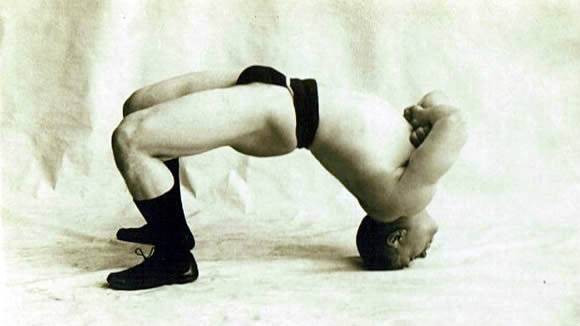
S&C Training for MMA: The Lifestyle Component
Some fighters are willing to train hard, but to have results like a pro, they also have to eat and rest like pros. I recommended that Viktor eat grass-fed meat, fish, eggs, vegetables, healthy fats (butter, ghee, coconut oil, good quality olive oil, avocados), rice, and potatoes. Also, plenty of water. We have cut grains, legumes (including soy and soy products), sweets, sweet soda drinks, artificial fats like margarine, vegetable oils, diary, and fast food. We added omega 3, probiotics, good quality protein drinks, and BCAAs as supplements.
As for regeneration, the order was to go sleep early (10:30pm at the latest), to have at least eight hours of good quality sleep (preferably more), and if possible get a short nap after the morning practice session. I have also prescribed simple cold showers protocol for better recovery.
Tapering for the Fight
In the end of 2014, Viktor left for Sweden to a training camp at Alexander Gustaffson‘s Allstar Team. The closer he came to his fight, the more sport specific Viktor’s strength and conditioning preparation was. As the fight approached, we reduced his kettlebell practice to two times a week, as his MMA prep was getting more and more intensive and would not tolerate anything more than the bare minimum of practice if both his preparation were to remain solid and his victory to be assured. Viktor recalls:
“When I arrived in Sweden for my MMA camp, many of my fellow fighters told me that I am stronger than the last time they saw me. I was happy to see the objectively measurable results. The StrongFirst-based strength and conditioning prep advantage is that it is not time consuming. Same goes for the equipment. I was traveling a lot, but I could find kettlebells in every gym, so I could continue with my training program.”
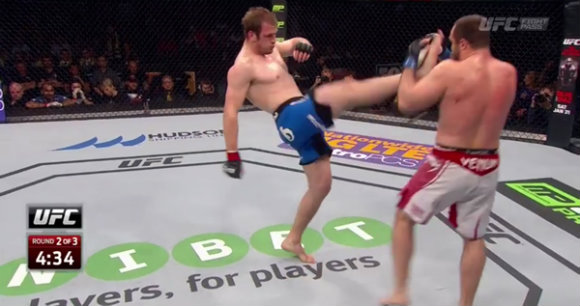 Viktor’s Sample Program – A/B Training Sessions
Viktor’s Sample Program – A/B Training Sessions
“A”
Morning Practice:
- Foam Rolling, Original Strength Resets – 10 minutes
- S&S Movement Prep – 3 circuits of (10x Halo, 5x StrongFirst Hip Bridge, 5x Prying Goblet Squat)
- S&S Swings – 10×10, active rest – MMA shadowboxing, done in the Fast & Loose way
- S&S Get-ups – 5+5
- Stretching
Afternoon Practice
- MMA
“B”
Morning Practice:
- Foam Rolling, Original Strength Resets – 10 minutes
- S&S Movement Prep – 3 circuits of (10x Halo, 5x StrongFirst Hip Bridge, 5x Prying Goblet Squat)
- S&S Swings – 10×10, active rest – MMA shadowboxing, done in the Fast & Loose way
- Push Presses – 10×10, active rest – MMA shadowboxing, done in the Fast & Loose way
- Stretching
Afternoon Practice
- MMA – pads, heavy bag, technique, sparring drills, sparring
Homework: Correctives, neck strengthening exercises, proper diet, enough rest.
Take careful note that his program encompasses more than simply lifting kettlebells. In true StrongFirst style, the quality of his movement as well as the quality of his recovery are elements that receive ample attention in his training, while making the right amount of room for the training needed to help him excel at his sport. As you’ll notice, what is the “right amount” changes as the demands of his sport practice change. The same holds true for any student. The ebb and flow of life demands an ebb and flow in training.
Keys to the Fight
The development of sustaining power (like the power wrought from StrongFirst’s Hardstyle kettlebell training) is one of the keys to success in MMA – you can’t count on a first round KO. Joe Rogan commented:
“This is a real lesson for fighters who are watching this as well – don’t always unload that gas tank – be prepared for a guy like Viktor Pešta.”
The Results
The judges scored the fight 3:0 for Viktor – unanimous decision victory (29-28, 30-27, 30-27). When asked about his strength and conditioning prep, Viktor said: “My strength and conditioning definitely helped me in the fight. Unlike my opponent I didn’t gas out in the first round and kept the pressure for all three rounds.”
Viktor, congratulations!
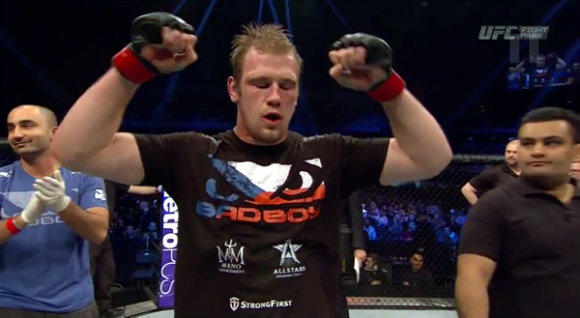
About Viktor Pešta: Viktor is currently the only Czech fighter in UFC. He trains MMA at Penta Gym Prague under Dan Barták and in Swedish Allstars Team with Alexander Gustafsson. His strength and conditioning preparation is taken care of by KB5 Gym Prague under the guidance of Pavel Macek, SFG Team Leader. Please visit Viktor‘s official Facebook page. Any type of PR or sponsorship is greatly appreciated!
(This article was humbly and gratefully edited and proofread by Aleks Salkin, SFG II, SFB – a friend of Pavel Macek and a fan of Viktor Pešta)
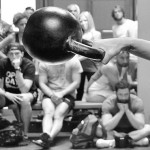
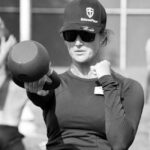

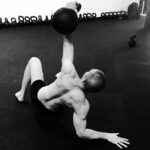
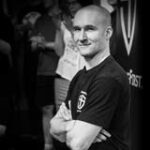






Hello, may I just ask why push presses and not military press with kettlebell? Would it be possible to go with military instead of push press? I just feel that I am able to do tecnicaly good military press but I am not sure about quality of my push presses..
Thanks Jan
From the article:
“Push presses were also done in an S&S way – 10×10 with a focus on maximum power output, with Fast & Loose shadow boxing between the rounds.”
Press is a grind, push press is an assisted grind, and it was chosen to complement the swing (power generation from the legs, from the ground up to the hand), S&S/Strong Endurance manner.
I can think of various ways how to implement presses, but not in this program.
Great article coach/Sifu Pavel, how far ahead of a fight or match would you stop strength and conditioning work?
Regards
Micah
Micah, we gradually lower the number of the training sessions per week, from 4 to 3 and eventually to 2. Fight week – either easier session (same weight, 2/3 volume), or we skip it.
Pavel,
In your article you are stating that you have eliminated grains but it states that he ate rice as well…what gives?
Borys – wheat. Rice is ok.
That’s an excellent article and great news, and it also shows the excellence of the S&S programme. I’ve experienced dramatic successes in lower level combat sports from adopting S&S as my strength and conditioning base.
Thank you for your kind words. S&S rocks!
Do you use Viking Push Presses, or the standard version?
Thanks,
Rick
Rick, standard.
This might sound like a dumb question, but for programming, was he using One-Arm swings? You say it was the S&S programming, but in the picture he’s using the 2hand Swing.
Just Curious
Matt,
It is a one arm swing. Viktor just touches his working arm on the top to make sure he doesn’t go into a rotation.
Hey great article! What’s a good way to incorporate kettle bell rows? I have found that it helps me with grappling. Also how many reps and sets for neck bridging, and how would you define neck bridge rolling??
Andrew,
I am happy you like the article. As for your questions:
a) kettlebell rows – no need.
b) we usually do 2 sets of 10. As for rolling neck bridge – start in a plank position, your feet and forehead in the contact with the floor, plus as much assistance of your hands as needed. Roll 360 degrees to your right, then repeat on your left. You can also start with the easier version, on the wall. Please refer to Pavel’s Beyond Bodybuilding book (p. 311-317), or Martial Power video series for detailed explanation.
Pavel,
Push Press 10×10 means: (10left, 10 right) x10, or 10L+10R ?
Max,
10L, rest, 10R, rest, 100 reps total (ie. 50 each arm), S&S way.
Thanks! 🙂
Great article!
I have a question. I was started S&S from 12weeks ago. And I got stronger. But When I did swing I feel my abs bracing is not enough strong. I want to do more powerful and perfect swing. I think practicing deadlift-plank in S&S is not adequate. Can I add hardstyle breathing& hardstyle plank practice? Is it unnecessary? If I can, how much? when? I need your advice.
Sorry for my clumsy english….
Spend more time on your swing technique – concentrate on quality, not quantity, let every single swing be Hardstyle. When working on your swing technique, you may alternate Hardstyle plank (with power breathing) and swing. Once you get it, brace your abs at the top of every single swing (=plank). Perfect practice makes perfect.
How would someone implement pull-ups int this program without over training the lats?
Daniel, you can add pull-ups, but you don’t have to. If you do, I suggest weighted pull-ups (and relatively light weight), 2-3 times a week, 3-5 reps.
hello Pavel, thanks I will do that. Other routines are just to complicated. Can I, when I start with 20 kilo and it’s get easy, move up to 24 etc. so can I use that routine for a long time? And is it better to do it 5 days a week or is 3 times enough in combination with my mma training?
Last question, it looks that this routine is enough for building strength but do you think it’s wise to run to 2 times a week?
Hello wim, yes, you can use it for a long time. Build a wide base (5-6 times a week), and when your fight is approaching, cut your S&C as outlined above to 3 times a week and then 2 times week. Don’t worry about the push press until you meet the “Simple” standards from Simple & Sinister.
As for running, you can (again, depends on your training schedule, fight schedule etc.), but you don’t have to. Work on proper breathing in your S&S program, and let your MMA training be the main cardio.
If you enjoy running, I suggest 2 easy runs, very relaxed, breathing only through your nose, in minimalistic shoes or barefoot. Don’t worry about the distance and time. Refer to Pavel’s and Dan John’s Easy Strength book for tips about fighter’s running programs and other excellent info.
Great article, i am surching long for a routine that makes me a bit stronger, give me more endurance etc. To supplement my martial arts training. I am 55 years and practice martial arts since the age of 15.
Of course i have a full time job, family etc. So i dont have hours a day to workout.
Heavy weightlifting is not for me, but s&s seems great. Is it realy that great? Can i get stronger, leaner with just that routinenext to my martial arts training? Dont i need heavy weights?
I teach martial arts to so for me its important to be in shape.
Wim, S&S is the way to go. Don’t give it a try – do it, move better, get stronger, and don’t look back.
Great post!
Love the simplicity of this and my own (non) MMA training follows a similar route although I do like to keep chin ups as a constant in all my training (GTG, ladders etc) and seem to thrive on a lower volume than this.
Simple is best but not always easy!
For the push presses, is it single or double bells? If single, are they done the same way as the tgu’s one left one right and back and forth or all ten left and all ten right?
Hunter:
– push presses – single bell
– done in the same way as the swings in Simple & Sinister
Great article!
What was the OS sequence you prescribed?
Thank you!
As for OS, nothing complicated – breathing, head nods, rolling, rocking, crawling.
Awesome. Yes I love S&S for fight conditioning and I love that idea about the Push Presses. Thanks!!
Thank you, Mike. As for Push Presses, credit to Pavel!
“Just enough is plenty”
So simple and perfectly said!
Great post
thank you